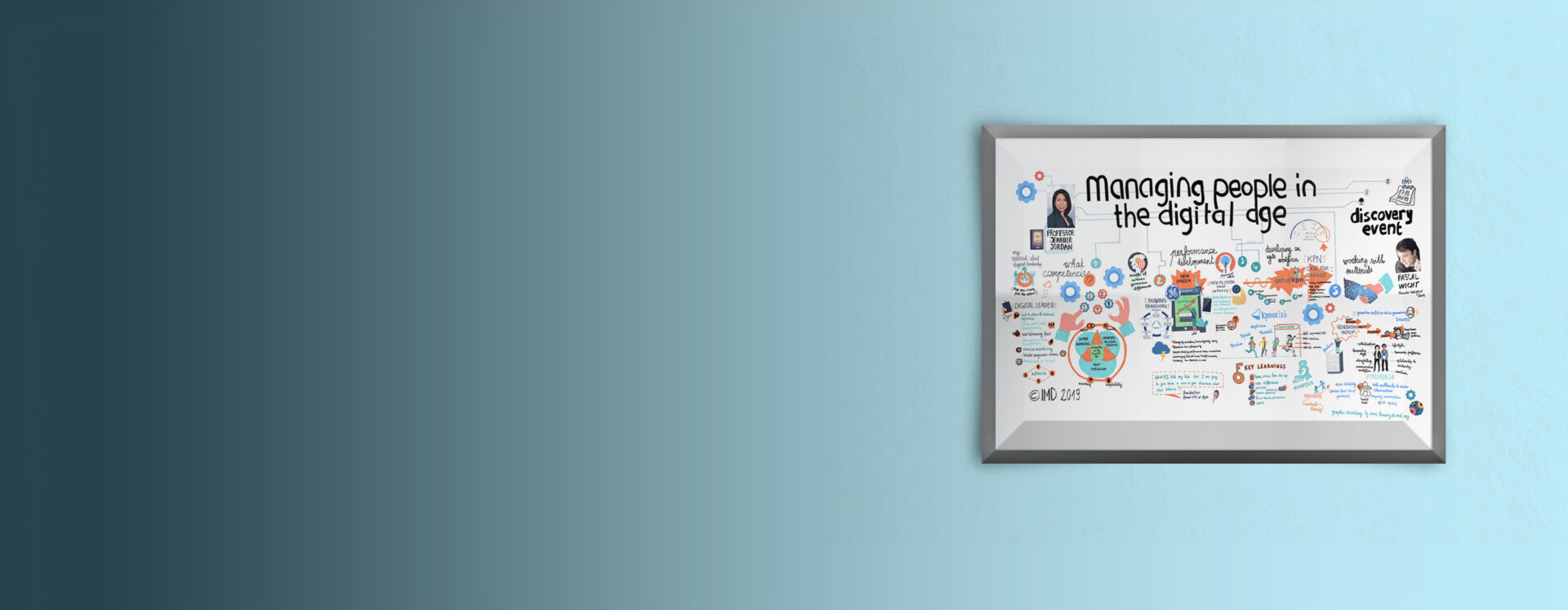At a Discovery Event on developing leaders amidst digital disruption, Professor Jennifer Jordan outlined the opportunities as well as the challenges that come with managing people in the digital age, as organizations seek to adopt agile and technology-driven approaches.
What unique traits or skills do leaders need to be successful in the digital age? This is a question that companies are increasingly asking themselves as the pace of digital transformation accelerates. And as companies focus more on innovation, many are also contemplating how employee performance development systems need to evolve.
How useful, really, is the traditional year-end performance review in a world of agile development and dynamic goal-setting? More generally, the need to rethink people management is brought into stark relief by the arrival of younger generations in the workforce. Millennials and Generation K (also referred to as Generation Z) bring their own values and skills to the leadership mix, which firms can seek to understand and then leverage for future growth.
Leadership redux
As the world enters the digital era, the practice of leadership is changing. What are the main differences? First, people in companies have traditionally looked to their leader for technical expertise. Today, staff often have deeper subject knowledge than their boss. Similarly, a core part of the leader’s job was to mentor junior colleagues, whereas now “reverse mentoring” – the pairing of senior executives with younger employees who advise them on current trends and technology – is gaining traction. On a more basic level, the leader was the “holder” of power in an organization. The current trend, in contrast, is for leaders to empower others. Organizations have also shifted from having teams collaborating face to face to working in virtual teams.
What about changes in the wider landscape? In the pre-digital age, people could control the level of transparency in their lives. They could determine what they wished to reveal about their life and identity outside of work, but 24/7 accessibility and social networks have since blurred the boundaries. The upshot is that building and leveraging one’s wider networks is increasingly essential to professional success. Lastly, the pace of change has accelerated, and the rise of new digital giants has upended market dynamics. Corporate leaders who previously had a good grasp of who their competitors were are now being blindsided by disruptors.
Executives’ take on the unique competencies needed to be successful in the digital age
- Unlearning: “We are ‘programmed’ by traditional schools but now we need to unlearn the things that aren’t relevant anymore, even if we’ve invested a lot in learning them!”
- Humility: “The work is complex, and we can’t know everything. We need to listen closely to others.”
- Vision: “Know where you ultimately want to go but be open about how to get there.”
- Resilience: “Challenging the status quo is uncomfortable. Personal resilience is key when you are publicly judged for both positive and negative performance.”
The portrait of a digital leader
From Angela Ahrendts at Burberry to John Stack at the Tate Modern museum, highly successful digital leaders tend to have eclectic backgrounds. Not all are technology experts. Instead, what these digital leaders have in common is a talent for shaping companies into future-oriented and digitally savvy new incarnations. These executives possess qualities that allow them to make a powerful case for change – even in traditional organizations – and then engage and inspire people to execute their vision.
IMD Professors Jennifer Jordan and Michael Wade have conducted research with over 1,000 senior business leaders globally to pinpoint the unique skills leaders need to be successful in the digital age. Their leadership model outlines seven essential competencies that predict success in digital companies, as well as in companies that are in the process of digitalizing:
- Informed decision making – “Making use of data and information to make evidence-based decisions.”
- Fast execution – “A willingness to move quickly, often valuing speed over perfection.”
- Hyper-awareness – “Constant scanning of internal and external environments for opportunities and threats.”
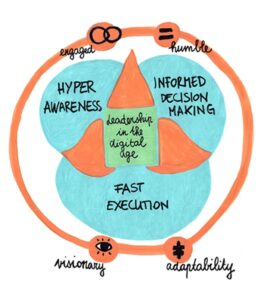
Successful digital leaders are also known to be:
- Humble – “I accept that others know more than me.” True humility stems from self-awareness. According to scientists, a humble person holds an accurate view of his or her strengths and weaknesses, and how they fit into the larger system. Tim Westergren, founder and CEO of the music-streaming company Pandora, embodies the qualities of a humble leader.
- Adaptable – “Changing my mind is a strength, not a weakness.” Successful leaders of the digital age are highly adaptable. In a context of fast-paced technological innovation, they are able to adapt their strategy and their approach. Interestingly, these leaders often combine the trait of adaptability with an opinionated nature.
- Visionary – “A clear vision is more important than a detailed plan.” Having a clear sense of direction for the long-term is essential, especially in the face of short-term uncertainty. Elon Musk is known for thinking three or four steps ahead of the engineers who work for him. As CEO of leading-edge technology ventures, Musk is also powerfully persuasive in communicating his vision for the future.
- Engaged – “I am always in listening mode.” Being engaged is a mix of two different qualities. The first is a willingness to listen, interact and communicate with stakeholders (both internal and external). The second is a strong sense of interest and curiosity in emerging trends.
Performance development in the digital age
The traditional year-end performance review is becoming a thing of the past for many companies. General Electric, after 40 years, ditched its widely known Employee Management System for a new way of looking at Performance Development. This was essential to support GE’s adoption of FastWorks – a start-up-inspired process for problem solving, based on fast iterations – in the quest to be more agile, lean and customer centric.
Using FastWorks in its development process, the HR team could leverage employees’ insights and rapid prototyping to build a new system with unique features, such as real-time feedback, upward feedback and dynamic goal-setting. However, initial test results were disappointing – no one used the tool as they felt uncomfortable actually providing the feedback in real-time and felt no clear incentive to do so.
Subsequent iterations resulted in a new PD@GE app designed to encourage a “growth mindset” rather than a “fixed mindset.” This system created a new terminology to help foster constructive conversations about performance – providing insights, as opposed to feedback, and suggesting continues or considers to inspire behavior change.
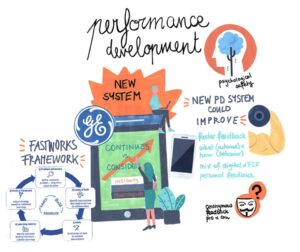
Lessons from the field: the art of designing performance development tools according to seasoned executives
- Because of the way they’re designed, many new performance development systems favor change-oriented people rather than those who are ‘running the shop.’ However, the system needs to be fair and reward both.”
- “We work agile, in sprints. After two weeks, we receive feedback, and after six weeks as well. Feedback stays within the team and it’s given face-to-face. It’s essential to have psychological safety in order to grow and improve based on feedback.”
- “The implementation of our new app was disastrous. People were confused and mistrustful because it was not clear how the reviews would be used: For example, would giving negative feedback affect someone’s bonus?”
- “It’s important not to lose the personal aspect. Feedback is better given in person and it’s important to provide context.”
The human side of digital transformations
One of the most difficult challenges for companies when they are undergoing digital transformation is to overcome the “corporate immune system.” New initiatives, new people and new technologies are often perceived as a threat by organizations. As a result, companies naturally create “antibodies” that kill nascent change initiatives. The Dutch telecom provider KPN was well aware of this risk and therefore created from scratch a separate innovation arm, tasked with creating a new IT infrastructure and client interface. This separate entity of around 30 scrum teams functioned in stealth mode for six months, giving them the freedom and autonomy to function in “start-up mode”, with faster ways of working and less corporate red tape to traverse. KPN also changed its hiring practices to better attract star software developers to the project.
So far, KPN’s digital transformation has saved the company €450 million after three years. On the client-facing side, KPN’s Net Promoter Score also improved by 20 points.
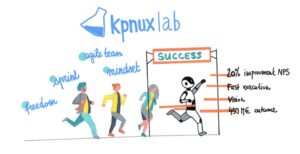
New generations: Mixing old and new in a digital world
As younger generations join the workforce, companies are realizing that they must adjust many internal processes in order to leverage the strengths of these digital natives. Millennials (born roughly between the years 1980 and 2000) and the following cohort, Generation K, have come of age in the digital era. They bring to the workforce new skills and new mindsets. Understanding these unique qualities is the first step for firms to create a fruitful generational mix.
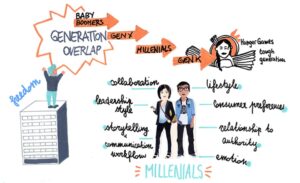
For example, Millennials have been shaped by cultural and political forces to appreciate different leadership models. They do not respond well to classic, top-down corporate hierarchies. Instead, they value a more collaborative approach in which they shape a fast, organic, bottom-up organization. They are also motivated by ambitious projects that fit a “quest” narrative. Tolkien’s Lord of the Rings hero Gandalf is the archetype of an attractive leader to Millennials. His laissez-faire leadership implies that he trusts the team to learn. Gandalf the wizard comes in only when he is needed, does not punish mistakes, protects and motivates the team, and is wholly reliable.
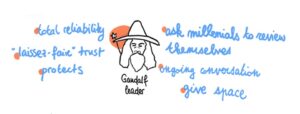
Divergent leadership models between older and younger generations, however, inevitably create tension in day-to-day management relationships. Many firms are grappling with how to give constructive feedback to Millennials in the context of performance development. Pascal Wicht, through his ethnographic approach to understanding Millennials, has concluded that the best method for performance feedback and development with Millennials is to create an ongoing conversation with weekly check-ins, rather than conduct formal performance reviews. In addition, bosses can start feedback sessions by asking Millennials to review themselves; they are a very critical generation and self-reflection helps them gain ownership of their performance. It is important for bosses to amplify positive performance, as Millennials are particularly sensitive to negative performance feedback. Then, as a second step, managers can help define solutions to weaker facets and thus take on a more inspirational coaching role.
Digital tools in the hands of Millennials
- Millennials have a natural affinity for mobile-first and cloud-based collaboration tools, which means this generation can be useful in testing and maximizing the utility of these tools.
- They perceive corporate IT to be unintuitive and complicated to use.
- They tend to embrace Shadow IT as a key to rapid progress and a pathway to digital transformation.
- As they leap to increase internal collaboration, Millennials may have to be reminded of the need to keep sensitive data fully private as their concepts of privacy differ from those of previous generations.
Conclusion
There is no single recipe for digital transformation: Every company takes a slightly different path in adapting to the digital age. In this sense, companies are like an orchestra that gradually introduces new instruments, section by section, until an entirely new symphony can be played. The best of these orchestras are those that foster the skills of digital leadership among their players and welcome younger performers into their ranks.
